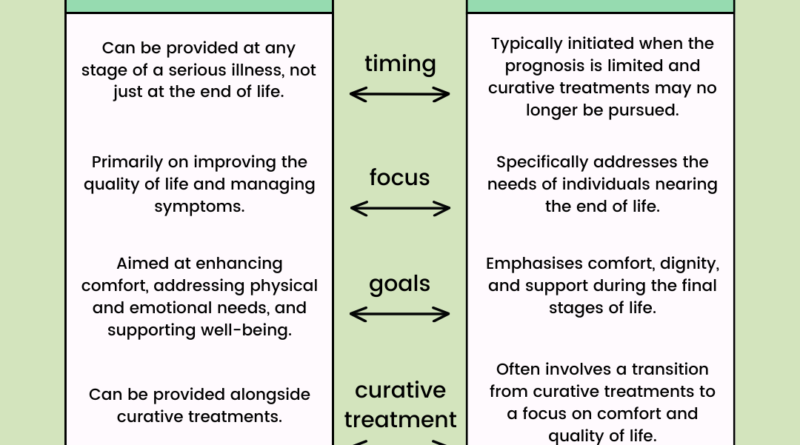Palliative Care vs. Hospice Care vs. End of Life Care: Understanding the Differences and Choosing the Right Option
Navigating the complexities of care options for individuals with serious illnesses can be overwhelming. Understanding the distinctions between palliative care, hospice care, and end-of-life care is crucial for making informed decisions that align with the patient’s needs and preferences. This blog aims to clarify these terms, explore their key features, and help you choose the right type of care for your loved ones or yourself.
What is Palliative Care?
Definition and Purpose
Palliative care is a specialized medical approach focused on providing relief from symptoms, pain, and stress associated with serious illnesses. Unlike curative treatments that aim to eradicate a disease, palliative care seeks to improve the quality of life for patients and their families. This type of care can be provided alongside curative treatments, meaning it is suitable at any stage of illness.
When It is Typically Provided
Palliative care is appropriate at any stage of a serious illness, from the time of diagnosis through treatment, and even after a cure is no longer possible. It is not limited by the stage of illness or prognosis and can be provided alongside aggressive treatments or as the primary approach if curative options are no longer viable.
Key Features and Services
- Symptom Management: Palliative care focuses on relieving symptoms such as pain, nausea, fatigue, and shortness of breath. It involves a multidisciplinary team, including doctors, nurses, and specialists, to address these issues comprehensively.
- Emotional Support: This care model provides counseling and emotional support to both patients and their families, helping them cope with the psychological and emotional challenges of serious illness.
- Coordination of Care: Palliative care teams work to coordinate care across different healthcare providers, ensuring that all aspects of a patient’s treatment plan are harmonized and aligned with their goals.
- Patient and Family Education: Educating patients and families about the illness, treatment options, and potential outcomes is a fundamental part of palliative care, enabling them to make informed decisions.
Who Can Benefit from Palliative Care
Palliative care is beneficial for individuals with serious, life-limiting conditions such as cancer, heart disease, chronic respiratory diseases, kidney failure, or neurodegenerative disorders. It is suitable for patients of all ages and at any stage of their illness, aiming to enhance comfort and quality of life.
What is Hospice Care?
Definition and Purpose
Hospice care is a type of palliative care specifically designed for individuals who are in the final stages of a terminal illness, with a life expectancy of six months or less. The focus of hospice care is on providing comfort and quality of life, rather than seeking to cure the illness.
When It is Typically Provided
Hospice care is typically provided when a patient has been diagnosed with a terminal illness and their treatment goals have shifted from curing the disease to focusing on comfort and quality of life. It is usually offered in the final months of life but can be initiated earlier if the patient and family wish to focus on comfort rather than curative treatments.
Key Features and Services
- Pain and Symptom Management: Hospice care ensures that pain and other distressing symptoms are managed effectively to enhance the patient’s comfort.
- Emotional and Spiritual Support: Hospice care includes counseling and spiritual support tailored to the patient’s and family’s needs, helping them navigate the emotional and existential aspects of end-of-life care.
- Respite Care: Hospice services often include respite care, which provides temporary relief for family caregivers, allowing them to rest and recharge while ensuring their loved one continues to receive care.
- Family Support: Hospice care extends support to family members, offering bereavement counseling and assistance with practical matters related to the patient’s care.
Who Can Benefit from Hospice Care
Hospice care is appropriate for individuals with a terminal diagnosis who have chosen to forego curative treatments in favor of comfort-focused care. It is designed to support patients and families in managing the final stages of life with dignity and compassion.
What is End of Life Care?
Definition and Purpose
End-of-life care encompasses the support and medical care given during the final days or weeks of a person’s life. The goal is to ensure that the patient is as comfortable as possible, addressing both physical and emotional needs as they approach the end of life.
When It is Typically Provided
End-of-life care is provided when a patient is approaching the final stages of their illness, typically within days or weeks of death. It focuses on managing symptoms and providing comfort during this critical time, ensuring that the patient’s final days are as peaceful and dignified as possible.
Key Features and Services
- Pain and Symptom Management: Similar to palliative and hospice care, end-of-life care prioritizes the relief of pain and other distressing symptoms to ensure the patient’s comfort.
- Compassionate Support: This care model emphasizes compassionate and respectful treatment, focusing on the patient’s comfort and dignity during their final days.
- Family Support: End-of-life care includes support for family members, helping them cope with the emotional aspects of the dying process and offering guidance on practical matters.
- Spiritual and Emotional Support: Providing emotional and spiritual support is crucial during this time, helping both patients and families find meaning and comfort.
Who Can Benefit from End-of-Life Care
End-of-life care is appropriate for patients who are nearing the end of their life, typically within days or weeks. It is designed to provide comfort and support during this final stage, addressing physical, emotional, and spiritual needs.
Differences Between Palliative Care, Hospice Care, and End of Life Care
Timing and Eligibility
- Palliative Care: This can be provided at any stage of a serious illness, including alongside curative treatments.
- Hospice Care: Typically for individuals with a terminal illness and a life expectancy of six months or less, focusing solely on comfort rather than curative treatments.
- End-of-life Care: Provided in the final days or weeks of life, focusing on comfort and dignity during the last stage of life.
Goals and Focus
- Palliative Care: Aims to improve quality of life through symptom management and emotional support, with the option to continue curative treatments.
- Hospice Care: Focuses on providing comfort and quality of life without curative treatments, supporting patients and families during the final stages of life.
- End-of-life care: Emphasizes comfort and dignity in the final days or weeks of life, providing compassionate support and managing symptoms.
Services Provided
- Palliative Care: Includes medical treatments, emotional and spiritual support, and coordination of care.
- Hospice Care: Offers pain and symptom management, emotional and spiritual support, and respite care for family caregivers.
- End-of-life Care: Focuses on pain and symptom management, compassionate support, and emotional and spiritual care during the final stages.
Similarities Between Palliative Care, Hospice Care, and End of Life Care
- Focus on Patient-Centered Care: All three care models prioritize the needs and preferences of the patient, aiming to enhance their quality of life.
- Emphasis on Quality of Life: Each approach focuses on improving the patient’s comfort and well-being, addressing physical, emotional, and spiritual needs.
- Provision of Emotional and Spiritual Support: Support for the emotional and spiritual aspects of illness and dying is a common feature, helping patients and families navigate their experiences.
- Support for Families and Caregivers: All three types of care offer support and resources for family members, recognizing their role in the patient’s care and well-being.
How to Choose the Right Type of Care
- Assessing the Patient’s Needs: Consider the patient’s current health status, prognosis, and treatment goals to determine the most appropriate type of care.
- Consulting with Healthcare Providers: Discussing options with healthcare providers can help clarify the best approach based on the patient’s medical condition and preferences.
- Considering Patient and Family Preferences: Take into account the patient’s and family’s wishes regarding treatment goals, quality of life, and the desired level of support.
- Evaluating Available Services and Resources: Research available care options and resources in your area to find providers that align with the patient’s needs and preferences.
Conclusion
Understanding the differences between palliative care, hospice care, and end of life care is essential for making informed decisions about managing serious illness and end-of-life care. Each approach offers unique benefits and focuses on enhancing comfort and quality of life in different ways. By considering the patient’s needs, preferences, and stage of illness, you can choose the right type of care to ensure the best possible experience for both the patient and their family.

